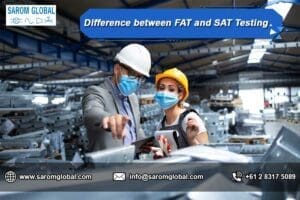Introduction of FAT and SAT Testing
FAT and SAT Testing are a significant part of a project’s execution and installation. Several projects require the services of a Factory Acceptance Testing Consultant before going on-site. This testing phase involves the ideation of correctly implementing the specified design in the software. The input is then simulated to test for the operation of the software. Also, software documents have to keep up to date so that the same documents can be further used to verify the accuracy of the operations of the software.
Factory Acceptance Testing or FAT
The main aim of conducting a FAT by a factory acceptance testing expert is to determine the safety system and the power factor correction systems. This test is usually conducted in the final stages of the design & engineering phases, just before the final installation in the industrial plant. This testing procedure is customised to validate the installed safety system and its safety functions according to the parameters of safety requirements.
Factory Acceptance Testing (FAT) includes the general testing procedures for the verification of the functioning accuracy of the installed safety system. Since the testing activities are in general, FAT is also applied to the programmable or non-programmable safety installation systems. The most critical part of FAT determines the specification of the test cases which should include a clear description of test cases, the test procedures, and the associated test cases.
However, it’s important to note that there are varying levels of FAT. They can be conducted at a basic level, such as configuring the main components of the system with temporary wiring to ensure that everything works as determined. More complete testing can be conducted where a manufacturer can physically integrate the whole system into your facility to test it completely.
Benefits of Factory Acceptance Testing
- The clients can touch and feel the system while in its operational mode before sending it.
- They can provide some operational tutorials that can give the operator more confidence in operating the machinery in the real environment.
- Comprehensive factory acceptance testing documentation can be used as a reference or template for the validated installation or installation qualification.
- Based on the outcomes of the FAT, both parties can devise a list of the additional elements which must be addressed before further processing.
Site Acceptance Testing and Commissioning
The Site Acceptance Testing (SAT) is performed after all the systems have been tested and validated. Prior to this final stage, the whole system must be tested as well as commissioned.
The step of commissioning is to verify all the physical inputs and outputs to each of the Programmable Automation Controller (PLCs ). A point list copy means the input and output list can be generated with the help of a column and the points are checked off while being verified.
One of the critical issues in the sense of discrete inputs is the normally open or normally closed type. This is the thing that can make a difference between the original design and the practical field-implemented system. Based on this the programmer can make the necessary changes as required and follow up on the document.
SAT is the final step to many projects. This is a continuous process where the system is kept on a test run for a period of 1–2 weeks without any problem. In case any problem arises the involved and concerned parties must meet again to discuss a solution to the problem or if any necessary change is needed.
The Site Acceptance Testing Services (SAT) Includes the Following Tests:
- Ending visual control
- Visual confirmation of the primary components
- The internal calibration of pressure and ventilation of the box
- The functionality of the utilities and configuration verifying
- Verification of the functionality or interlocks (Mechanics and Software)
- Testing for the dispensing systems (as per the client’s requirements)
- Verification of dose calibrator (as per the client requirements)
- Checking of the safety devices & interlocks
- Operator’s training
Delivering of the Factory Acceptance Testing Protocol and the Documentation of the Package, which Includes:
Factory acceptance testing protocol accomplished
- Maintenance and user manual
- A list of the recommended additional parts
- A Certificate of Compliance
- The technical drawings (electrical, mechanical, pneumatic along with process designs)
- Certificates of the materials and data sheets
- The primary/concerned equipment data sheets
- The instrument calibration certificates
- The qualification of the welding process
The Major Difference between FAT and SAT Testing would be in Terms of the Scope of Testing
The FAT and SAT Testing differences are as follows:
- The major control systems, field instruments, and switchgear are not available during factory assessment testing (FAT). Often only partial testing happens with typical sub-systems during the integrated testing phases. This requires a lot of micro-planning since the entire testing needs to be done with all the stakeholders in one place.
- The above-integrated SAT testing is possible when and where all the field instruments, unit packages, all communication interfaces, and switchgear are available for testing together.
- The major problems found during SAT are IP conflicts or mismatches, network overloading, communication module interference or hang, incompatibility of the I/O card, NO or NC wiring, alarm flooding, and so on.
Contact us
SAROM GLOBAL
info@saromglobal.com

